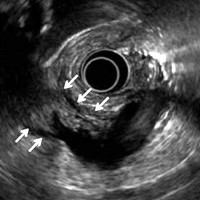Novel Tissue Harmonic Imaging Clearly Visualizes a Case of Intraductal Papillary Mucinous Neoplasm with Mural Nodules
Abstract
Tissue Harmonic Echo (THE) imaging is a sonographic technique that potentially provides images of higher quality than can conventional B-mode images. Potential advantages of THE imaging include improved resolution, improved signal-to-noise ratio, and reduced artifacts [1, 2]. Recently, a novel THE imaging performed using an EUS system with a monitor/processing unit (EU-ME2 PREMIER PLUS; Olympus Medical Systems, Tokyo, Japan) has been developed. Using this technology, we can obtain two THE mode images, namely, THE-P (penetration) and THE-R (resolution). The THE-P mode is suitable for middle range distance observation because it receives a harmonic signal whose frequency is mainly 7.5 MHz. The THE-R mode is suitable for close distance observation from the probe because it receives a harmonic signal whose frequency mainly ranges from 10 to 12 MHz. Here, we report a case of intraductal papillary mucinous neoplasm (IPMN) with mural nodules which could be clearly detected using this novel THE imaging.
Image: P-mode image.
Downloads
References
Shapiro RS, Wagreich J, Rarsons RB, Stancato-Pasik A, Yeh HC, Lao R. Tissue harmonic imaging sonography: evaluation of image quality compared with conventional sonography. Am J Roentgenol. 1998; 171:1203-1206. [PMID:9798848]
Ishikawa H, Hirooka Y, Itoh A, Hashimoto S, Okada N, Itoh T et al. A comparison of image quality between tissue harmonic imaging and fundamental imaging with an electronic radial scanning echoendoscope in the diagnosis of pancreatic diseases. Gastrointest Endosc. 2003; 57:931-936. [PMID:12776049]

Copyright (c) 2014 Kazuyuki Matsumoto, Akio Katanuma

This work is licensed under a Creative Commons Attribution 4.0 International License.
As a member of Publisher International Linking Association, PILA, iMedPub Group’s JOP follows the Creative Commons Attribution License and Scholars Open Access publishing policies. Journal of the Pancreas is the Council Contributor Member of Council of Science Editors (CSE) and following the CSE slogan Education, Ethics, and Evidence for Editors.